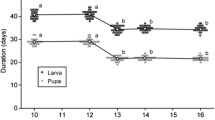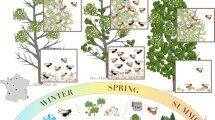Abstract
Knowledge about the development and bioecology of red-banded thrips, Selenothrips rubrocinctus (Giard, 1901) (Thysanoptera: Thripidae), is scarce. In this work, we tested the hypothesis that the development of S. rubrocinctus is affected by the rose cultivar in which it grows. The biological characteristics of this thrips in two rose cultivars were evaluated and the species life table was elaborated. The development time and viability of egg, nymph of 1st and 2nd instar, pre-pupa and pupa stages were evaluated in Avalanche and Príncipe Negro cultivars, with 100 specimens per cultivar. The two-sex life table was elaborated considering biological, demographic and reproductive parameters, starting with 100 immatures. A total of 73 adults were obtained (94.52 % females). The average embryonic and pre-imaginal development time (egg - adult) was 11.16 and 21.03 days (d), respectively. The average longevity of adults was 9.45 d, and the complete biological cycle was 30.48 d. The average total fertility was 17 eggs per female. Of the total eggs produced, 70.5 % were viable. The intrinsic rate of increase (r), the finite rate of increase (λ), the net reproductive rate (R0) and the mean generation time (T) were 0.094 (d−1); 1.10 (d−1); 11.73 (offspring/specimen); and 26.19 (d), respectively. The cultivars of rose bushes did not affect the biological characteristics of the pre-adult stage of the thrips. In addition, the high survival rate favored the population growth, with no variation in biological aspects. These results show that the rose bush is a suitable host for the development of S. rubrocinctus.








Similar content being viewed by others
Data availability
Supplemented materials are attached.
Code availability
Not applicable.
References
Agrofit (2021) Consulta de pragas: Selenothrips rubrocinctus. http://agrofit.agricultura.gov.br/agrofit_cons/principal_agrofit_cons. Accessed 21 Apr 2021
Akkopru EP, Atlhan R, Okut H, Chi H (2015) Demographic assessment of plant cultivar resistance to insect pests: a case study of the dusky-veined walnut aphid (Hemiptera: Callaphididae) on five walnut cultivars. J Econ Entomol 108(2):378–387. https://doi.org/10.1093/jee/tov011
Alves-Silva E, Del-Claro K (2010) Thrips in the Neotropics: what do we know so far? Trends Entomol 6(1):77–88
Brown H, Chin D (2013) Red-banded thrips on fruit trees. Northern Territory Government 134:1–3
Burden RL, Faires JD (2011) Numerical analysis, 9th edn. Brooks/Cole, Cengage Learning, Mason
Carey JR (1993) Applied demography for biologists with special emphasis on insects. Oxford University Press, New York
Carvalho ANM (2011) Distribuição espacial, plano de amostragem e caracterização de injúrias causadas por tripes (Thysanoptera: Thripidae) em videira. Tese, Universidade Federal Rural de Pernambuco
Carvalho CF, Souza B (2009) Métodos de criação e produção de crisopídeos. In: Bueno VHP (ed) Controle biológico de pragas: produção massal e controle de qualidade. Editora UFLA, Lavras, pp 77–115
Carvalho LM, Souza B, de Sousa ALV (2019) Ornamental plants. In: Souza B, Vázquez L, Marucci R (eds) Natural enemies of insect pests in Neotropical agroecosystems. Springer International Publishing, Cham, pp 355–368. https://doi.org/10.1007/978-3-030-24733-1_29
Chang C, Huang CY, Dai SM, Atlihan R, Chi H (2016) Genetically engineered ricin suppresses Bactrocera dorsalis (Diptera: Tephritidae) based on demographic analysis of group-reared life table. J Econ Entomol 109(3):987–992. https://doi.org/10.1093/jee/tow091
Chi H (1988) Life-table analysis incorporating both sexes and variable development rates among individuals. Environ Entomol 17(1):26–24. https://doi.org/10.1093/ee/17.1.26
Chi H (2020) TWOSEX-MSChart: a computer program for the age-stage, two-sex life table analysis (Version 2020.01.12). http://140.120.197.173/Ecology. Accessed 15 Jan 2021
Chi H, Liu H (1985) Two new methods for the study of insect population ecology. Bull Inst Zool Acad Sin 24(2):225–240
Chi H, Su HY (2006) Age-stage, two-sex life tables of Aphidius gifuensis (Ashmead) (Hymenoptera: Braconidae) and its host Myzus persicae (Sulzer) (Homoptera: Aphididae) with mathematical proof of the relationship between female fecundity and the net reproductiv. Environ Entomol 35(1):10–21. https://doi.org/10.1603/0046-225X-35.1.10
Denmark HA, Mound LA, Marullo R (1996) The thrips of central and south America: an introduction (Insecta: Thysanoptera). Fl Entomol 79(2):270. https://doi.org/10.2307/3495826
Denmark H, Wolfenbarger DO (2016) Redbanded thrips, Selenothrips rubrocinctus (Giard) (Insects: Thysanoptera: Thripidae). EDIS - UF/IFAS Extension 108:1–4
Efron B, Tibshirani R (1993) An introduction to the bootstrap. Chapman & Hall, New York
Fennah R (1963) Nutritional factors associated with seasonal population increase of cacao thrips, Selenothrips rubrocinctus (Giard) (Thysanoptera), on cashew, Anacardium occidentale. Bull Entomol Res 53(4):681–713. https://doi.org/10.1017/S0007485300048434
Fennah R (1965) The influence of environmental stress on the cacao tree in predetermining the feeding sites of cacao thrips, Selenothrips rubrocinctus (Giard), on leaves and pods. Bull Entomol Res 5(2):333–349. https://doi.org/10.1017/S000748530005642X
Fisher R (1930) The genetical theory of natural selection. Clarendon Press, Oxford
Gallo D et al (2002) Entomologia agrícola. FEALQ, Piracicaba
Goodman D (1982) Optimal life histories, optimal notation, and the value ofreproductive value. Am Nat 119:803–823
Huang Y, Chi H (2011) The age-stage, two-sex life table with an offspring sex ratio dependent on female age. J Agric For 60(4):337–345
Igboekwe AD (1985) Injury to young cashew plants, Anacardium occidentale L., by the red-banded thrips, Selenothrips rubrocinctus Giard (Thysanoptera: Thripidae). Agric Ecosyst Environ 13(1):25–32. https://doi.org/10.1016/0167-8809(85)90098-2
Krebs C (1972) Ecology: the experimental analysis of distribution and abudance. Harper & Row, New York
Lorenzi H, Souza HM (2008) Plantas ornamentais no Brasil: arbustivas, herbáceas e trepadeiras, 4th edn. [s.l.] Instituto Plantarum, Nova Odessa
Mascarenhas ALS, Silvia MJP, Silva Junior JC (2016) Tisanopterofauna associada à plantas ornamentais e cultivadas no Sudoeste Baiano. Entomo Brasilis 9(1):31–35. https://doi.org/10.12741/ebrasilis.v9i1.536
Masarovič R, Doričová M, Prokop P, Fedor P (2014) “Testing the limits” — an interesting record of the exotic banded greenhouse thrips Hercinothrips femoralis (Thysanoptera: Thripidae: Panchaetothripinae) at high Carpathian mountain altitudes. Biologia 69:1631–1634. https://doi.org/10.2478/s11756-014-0458-5
Mound L (2002) Thysanoptera biodiversity in the Neotropics. Rev Biol Trop 50:477–488
Nondillo A, Redaelli LR, Pinent SMJ, Botton M (2009) Biologia e tabela de vida de fertilidade de Frankliniella occidentalis (Pergande) (Thysanoptera, Thripidae) em morangueiro. Rev Bras Entomol 53(4):679–683. https://doi.org/10.1590/S0085-56262009000400020
Paiva J (2010) Praga ataca mais de 3 mil cajueiros. Jornal de Fato. http://www.tribunadonorte.com.br/noticia/praga-ataca-mais-de-3-mil-cajueiros/149484. Accessed 25 Nov 2020
Peña J (2008) Plagas del palto en Florida. In: Renato R, Pilar L (eds) Manejo de Plagas en Paltos y Cítricos. Hotel Del Mar, Fontagro, pp 310–316
Pragyan SS, Mukherjee SK (2021) Studies on biology of red banded foliage thrips (Selenothrips rubrocinctus) under Bhubaneswar conditions of Odisha. J Pharmacogn Phytochem 10(1):2754–2756
Pressat R (2020) The dictionary of demography. Bell and Bain, Ltd, Glasgow
Procházková L, Bella J, Fedorová J (2021) Did climate change induce infiltration of composite thrips Microcephalothrips abdominalis sexual populations in Central Europe? Biologia 76:1785–1788. https://doi.org/10.2478/s11756-020-00664-y
R Core Team (2020) The Comprehensive R Archive Network (Version 4.0.2). https://brieger.esalq.usp.br/CRAN/. Accessed 16 Nov 2020
Reitz S (2009) Biology and ecology of the western flower thrips (Thysanoptera: Thripidae): the making of a pest. Fl Entomol 92(1):7–13. https://doi.org/10.1653/024.092.0102
Sánchez-Soto S, Nakano O (2004) Primeiro registro de Selenothrips rubrocinctus (Giard) (Thysanoptera: Thripidae) atacando lichia no Brasil. Neotrop Entomol 33(3):395–396
Sarmiento HKF (2014) Integrated pest management of western flower thrips. Faculty of Science, Universiteit Utrecht
Silva APN (2018) Criação em laboratório e tabela de vida de Allograpta exotica (Diptera: Syrphidae). Dissertação, Universidade Federal de Lavras (UFLA)
Soesanthy F, Maryana N, Sartiami D, Karmawati D (2012) Biologi Selenothrips rubrocinctus Giard (Thysanoptera: Thripidae) pada Tanaman Jarak Pagar. Buletin Ristri 3(3):207–216
Stancioli AR (2018) Selenothrips rubrocinctus. Defesa Vegetal. http://www.defesavegetal.net/slenru. Accessed 20 Nov 2020
Tuan SJ, Lee CC, Chi H (2014a) Population and damage projection of Spodoptera litura (F.) on peanuts (Arachis hypogaea L.) under different conditions using the age-stage, two-sex life table. Pest Manag Sci 70(5):805–813. https://doi.org/10.1002/ps.3618
Tuan SJ, Lee CC, Chi H (2014b) Population and damage projection of Spodoptera litura (F.) on peanuts (Arachis hypogaea L.) under different conditions using the age-stage, two-sex life table. Pest Manag Sci 70(12):1936–1936. https://doi.org/10.1002/ps.3920
Wittmeyer JL, Coudron TA (2001) Life table parameters, reproductive rate, intrinsic rate of increase, and estimated cost of rearing Podisus maculiventris (Heteroptera: Pentatomidae) on an artificial diet. J Econ Entomol 94(6):1344–1352
Woin N, Guyen Ban J, Cirad C, Mpe J (1995) Etude biologique de Selenothrips rubrocinctus ravageur du cacaoyer, du goyavier, et du manguier au Cameroun. Fruits 50(1):51–58
Zvaríková M, Masarovič R, Bohuš M, Prokop P, Fedor P (2017) Another climate change induced infiltration? The northernmost record of thermophilous spore-feeding Allothrips pillichellus (Thysanoptera: Phlaeothripidae: Idolothripinae). Biologia 72:961–964. https://doi.org/10.1515/biolog-2017-0098
Acknowledgements
We thank the Laboratório de Controle Biológico com Entomófagos (LCBE) for providing the infrastructure to conduct the experiments. We really thank Prof. Dr. Élison Fabrício B. Lima from the Universidade Federal do Piaui, PI, Brazil, for having confirmed the specific identity of S. rubrocinctus.
Funding
This study was financed in part by the Coordination for the Improvement of Higher Education Personnel (CAPES), Brazil (Finance Code 001). This manuscript was written as part of the master’s dissertation conducted by JRS, who received a scholarship from CAPES; MNM was supported by CAPES (proc. PNPD 20131282).
Author information
Authors and Affiliations
Contributions
All authors contributed to the conception and design of this research. Preparation of material, insect rearing and cultivation of rose bushes, data collection, entry of the first version and final manuscript formatting were carried out by Jailma Rodrigues dos Santos. Guidance, tabulation and statistical analysis of the data, interpretation and correction of previous versions of the manuscript were carried out by Mírian Nunes Morales and Marvin Mateo Pec Hernández. Guidance on conducting experiments and correcting previous versions of the article by Brígida Souza. All authors read and approved the final manuscript.
Corresponding author
Ethics declarations
Conflict of interest
The authors declare that they have no known competing financial interests or personal relationships that could have appeared to influence the work reported in this paper.
Additional information
Publisher’s note
Springer Nature remains neutral with regard to jurisdictional claims in published maps and institutional affiliations.
Rights and permissions
About this article
Cite this article
dos Santos, J.R., Morales, M.N., Pec Hernández, M.M. et al. Can Selenothrips rubrocinctus (Thysanoptera: Thripidae) become a new pest in rose bush?. Biologia 77, 411–421 (2022). https://doi.org/10.1007/s11756-021-00942-3
Received:
Accepted:
Published:
Issue Date:
DOI: https://doi.org/10.1007/s11756-021-00942-3




